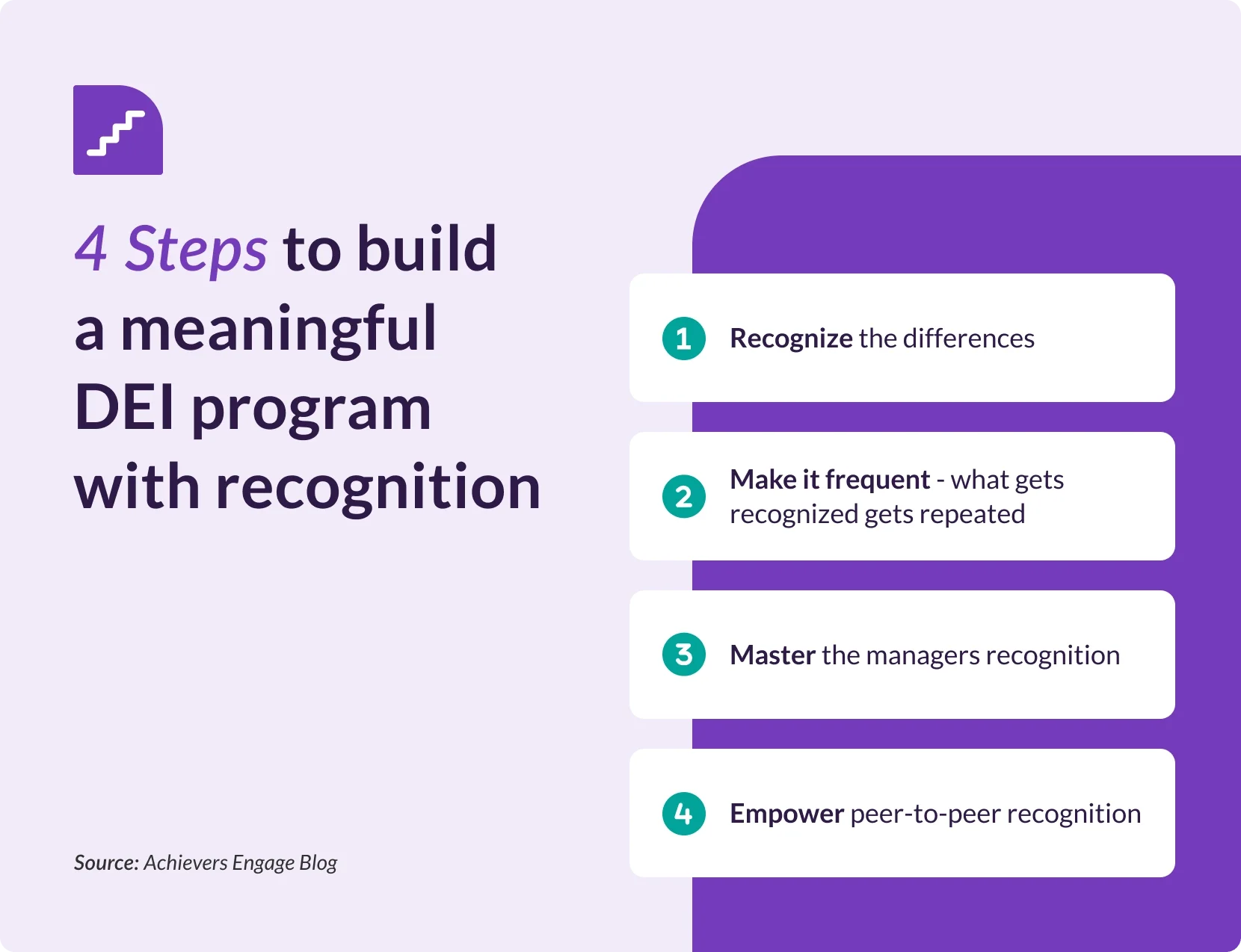Table of contents
Companies that are truly committed to building a result-driven diversity, equity, and inclusion (DEI) program are ready to take their initiatives to the next level. In this blog, you will find our guide to help you amplify your DEI programs with recognition. From understanding different types of diversity to weaving recognition into your DEI efforts and driving measurable impact, this blog will help you look at DEI from a more personal level.
Different types of diversity in the workplace
The term diversity has a broad definition, and it is common to lump different types of diversity at work under one umbrella. Diversity is the recognition and inclusion of many differences that exist among individuals. An impactful DEI program starts with understanding what diversity really means instead of using it as a fluffy HR term. From characteristics, such as race, age, gender, and sexual orientation, to socioeconomic status, diversity means so much in between that organizations often miss. Two types of diversity, external and internal, play a key role in the workplace.
1. What is external diversity?
External diversity refers to things that are related to an individual but are not characteristics that an individual was born with. Since external diversity can be influenced by other people and their surrounding environment, it includes components that a person can control and change over time. Some examples of external diversity include education, religious and political beliefs, socioeconomic status, life experiences, citizenship, and personal values. These aspects contribute to a person’s worldview and skill traits that inform their work and problem-solving approaches.
2. What is internal diversity?
Internal diversity includes characteristics that an individual is born into and cannot control. While race and ethnicity are a part of internal diversity, they also tell a story of a person’s cultural background and upbringing. At work, companies often neglect physical and mental ability as an important part of their DEI program. An example of a crucial but often missing factor of DEI is neurodiversity.
A neurodiverse workplace promotes innovation, creativity, and different ways to solve problems while improving employees’ perceptions of DEI and a supportive company culture. Neurodiversity can be a huge asset for companies; however, most employers don’t recognize their neurodiverse talent or are not ready to do so. When employees open up to their managers about their ADHD conditions, 59% of managers say that they don’t feel prepared to respond. A recent AWI research on tough conversations at work found that one-third of employees say they don’t feel safe having hard conversations with their managers. Trust is an important factor in cultivating a healthy and supportive workplace culture. To develop trust, companies should first understand the crucial role of recognition in their DEI program.
Recognition as a DEI program initiative
Recognition is often an undervalued and missing ingredient from a company’s DEI program. AWI’s 4th annual State of Recognition report found that companies with an online employee recognition are twice as likely as those with an in-house program to say their recognition strategies drive organizational outcomes, including employee connection and retention, and Diversity, Equity, Inclusion, and Belonging (DEIB). To improve this, we have identified four ways to help HR leaders weave strategic recognition into their DEI program and drive measurable impact. It’s important to note that implementing a fully-featured employee recognition tool can be a powerful step toward embedding recognition seamlessly into DEI efforts for stronger, more inclusive results.
4 ways to build a meaningful DEI program with recognition

1. Recognize the differences
While many companies have incorporated diversity into their organizational policies and practices, sometimes that is not enough to make employees feel heard and included. Organizations should stop seeing diversity as a checkbox exercise, and start educating workers on different types of diversity and develop DEI training for managers to help them become better people leaders. Recognizing that your employees have different work styles and approaches to problem-solving can bridge the gap between employees and managers, and cultivate a culture of safety for tough conversations.
2. Make it frequent – what gets recognized gets repeated
Higher recognition frequency correlates with positive employee outcomes. When employees are recognized at least monthly, the number of individuals reports feeling engaged and productive at work almost doubles compared to those who get recognized less frequently. Frequent recognition, then, is the key to reinforcing positive behaviours and embracing employees’ sense of belonging. Recognition should be done strategically and meaningfully, and it starts with managers.
3. Master the managers recognition
A 2023 EY study on belonging at work found that 63% of employees across generations prioritize DEI when choosing their place to work. While this means that having a robust DEI program can attract diverse talents, only a truly impactful program can make employees want to stay at their company long-term. Managers recognition can build a culture where employees feel included and belonged. Our 2024 AWI research on tough conversations at work shows that employees who feel recognized by their manager are twice as likely to have high trust and are almost twice as likely to say they feel safe having tough conversations with their manager.
While HR and people leaders must focus on managers recognition as a crucial component of their DEI initiatives, don’t forget that peer recognition is also highly empowering.
4. Empower peer-to-peer recognition
Peer-to-peer recognition is a culture and connection builder. With peer recognition, a diverse workplace can efficiently and meaningfully connect their employees together while embracing different types of diversity. Our 2024 State of Recognition report emphasizes the importance of peer recognition: those who receive at least monthly recognition from their peers are twice as likely to feel a strong sense of belonging. HR leaders who want to bring their DEI program to the next level must strengthen managers recognition and increase peer recognition.
Drive your business goals with a strategic recognition program
Is your DEI program driving meaningful results? Do you have employee recognition as a DEI initiative? If not, time to amplify your DEI efforts with recognition. Our research at AWI looks into recognition as a strategic practice that can be weaved into every aspect of your business and help HR leaders obtain the outcomes they need. Read our 2024 State of Recognition report now to learn more.
Discover what makes an online employee recognition platform effective.
See the 2024 Recognition ReportDiscover what makes an online employee recognition platform effective.
See the 2024 Recognition Report
